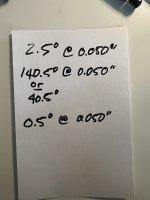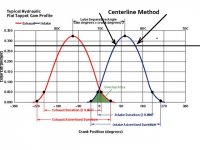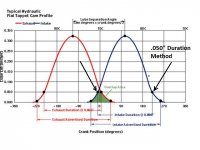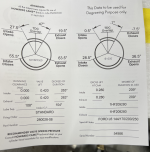You know that you have it set up on the exhaust lobe now, right?
You are using an out of date browser. It may not display this or other websites correctly.
You should upgrade or use an alternative browser.
You should upgrade or use an alternative browser.
All Small Six Installing and Degreeing Camshaft - 1983 200lm
- Thread starter Dr_Dan_WWW
- Start date
This relates to all small sixes
Good catch!You know that you have it set up on the exhaust lobe now, right?
Once again I believe I missed something. Or probably more accurately: I don't fully understand what the numbers mean. But here is my step by step of the instructions:
(my calculations below)
View attachment Bronco 1983 engine cam degree 2 IMG_7328.MOV
CW 147* @ .50"
continued CW 74* @.50"
= 221/2 = 110.5*
Well, at least I am consistently wrong!
So IF these readings are correct, what happens? Do I remove the graduated crank gear (from V.I) and retard or advance it 6 degrees? Moreover, why would the Howard camshaft be "off?" It feels like I musta done something wrong.
(my calculations below)
View attachment Bronco 1983 engine cam degree 2 IMG_7328.MOV
CW 147* @ .50"
continued CW 74* @.50"
= 221/2 = 110.5*
Well, at least I am consistently wrong!
So IF these readings are correct, what happens? Do I remove the graduated crank gear (from V.I) and retard or advance it 6 degrees? Moreover, why would the Howard camshaft be "off?" It feels like I musta done something wrong.
Three things
You are still on the wrong cam lobe with the lifter. You need to be on the intake cam lobe not the exhaust lobe.
You did not go far enough on the return side.
It is .050" from the lifter bottom once you pass max lift, not .050" down from max lift.
You are not reading the wheel correctly.
The exhaust opening reading is 33 BBDC not 147.
The cam card shows 36.5 BBDC for that point.
The second reading will be close to 3 degrees BTDC not 74
The cam card actually shows 7 degrees BTDC at that point.
You are still on the wrong cam lobe with the lifter. You need to be on the intake cam lobe not the exhaust lobe.
You did not go far enough on the return side.
It is .050" from the lifter bottom once you pass max lift, not .050" down from max lift.
You are not reading the wheel correctly.
The exhaust opening reading is 33 BBDC not 147.
The cam card shows 36.5 BBDC for that point.
The second reading will be close to 3 degrees BTDC not 74
The cam card actually shows 7 degrees BTDC at that point.
Last edited:
Note that I deleted my previous post number 105 I had it wrong.
Good grief. No, I didn't know I am the wrong lifter. Thanks for the correction. "I assumed..." and you know the rest of the line.You know that you have it set up on the exhaust lobe now, right?
Third attempt to degree the cam. This time I am on the intake lifter. Thanks drag-200.

View attachment Bronco 1983 engine cam degree 3 IMG_7328.MOV
Any advice is appreciated. Thank you all so very much.

View attachment Bronco 1983 engine cam degree 3 IMG_7328.MOV
Any advice is appreciated. Thank you all so very much.
You posted the second try video instead of the third try video.Third attempt to degree the cam. This time I am on the intake lifter. Thanks drag-200.
View attachment 11388
According to the numbers you posted above you are still not going far enough on the back side of the cam lobe.
You need to go until the lifter is .050" from it's lowest point, not .050" down from the highest point.
You are doing a great job getting the readings.
We just need you to get the correct ones. LOL
Last edited:
It is more important that you understand what you are doing.
Your first attempt where you took two readings down from the max lobe lift is called the center line method.
The two arrows below show where those two points are on the intake cam lobe.
You take the distance between those two points and divide by 2.
Then you add the result to the first reading and that will give you the center point.
The cam card states that the intake center point (C/L) should be at 104 degrees after TDC.

The cam card uses the two points that are .050" up from the bottom of the cam lobe as shown by the two arrows below.
That is called the .050" duration method.
Again, you take the distance between those two points and add the result to the first reading to get the center point.
If the cam lobes are symmetrical, the center will still be at 104 ATDC.

Your first attempt where you took two readings down from the max lobe lift is called the center line method.
The two arrows below show where those two points are on the intake cam lobe.
You take the distance between those two points and divide by 2.
Then you add the result to the first reading and that will give you the center point.
The cam card states that the intake center point (C/L) should be at 104 degrees after TDC.

The cam card uses the two points that are .050" up from the bottom of the cam lobe as shown by the two arrows below.
That is called the .050" duration method.
Again, you take the distance between those two points and add the result to the first reading to get the center point.
If the cam lobes are symmetrical, the center will still be at 104 ATDC.

Last edited:
Sorry about the wrong video. Here's the 3rd try. Also pmuller9, on this third try I just kept turning the crank clockwise, assuming I am not going far enough. See if I go as far as you are telling me. I didn't write on the card my final number, which you will see near the end of the video: 30.5* or 149.5*. My interpretation of the cam card tells me I am looking for 28.5* - if I read the cam card right (and I haven't read right so far ), the 30.5 may be the number to use for intake close. You tell me.
), the 30.5 may be the number to use for intake close. You tell me.
I kept turning the wheel after the 30.5* but it appeared that the I was on the "open space" at bottom of the lobe.
I will study the graphs above, and hopefully understand what is happening. Thanks you again and again. I think I'm having fun - if fun includes frustration and feeling dumb.
View attachment Bronco 1983 engine cam degree 3 IMG_7337.MOV
I kept turning the wheel after the 30.5* but it appeared that the I was on the "open space" at bottom of the lobe.
I will study the graphs above, and hopefully understand what is happening. Thanks you again and again. I think I'm having fun - if fun includes frustration and feeling dumb.
View attachment Bronco 1983 engine cam degree 3 IMG_7337.MOV
You did great.
The last .050" that was at 30.5 after BDC is .050" from the bottom and is the reading you needed.
The first .050" reading was 2.5 After TDC and the second reading is 30.5 After BDC
From 2.5 ATDC to BDC is 180 - 2.5 = 177.5
Then you went another 30.5 which brings the total duration distance 177.5 + 30.5 = 208 degrees.
You will notice the cam card shows the .050" duration as 209 degrees so you are very close in taking the readings.
Now you have to find the center point between the two .050" readings.
Take half of the 208 duration that you measured, 208/2 = 104
Now add that to the starting point which is 2.5 After TDC, 104 + 2.5 = 106.5 ATDC.
The cam card calls for the center line (C/L) to be at 104 degrees ATDC so the cam is 1.5 degrees advanced rather than 4 degrees advanced.
The cam is considered zero advance or straight up when the center line is the same as the Lobe Separation Angle which is 108 in this case.
If this cam is at 106.5 it is 1.5 degrees advanced instead of 4 degrees advanced at 104.
Since you can only move the cam in 4 degree increments I would leave it at 106.5 which is between being straight up at 108 and advanced at 104.
It is a good place to be.
The power band is shifted upward slightly but more important, the engine is less prone to detonation than if you advance it more.
The last .050" that was at 30.5 after BDC is .050" from the bottom and is the reading you needed.
The first .050" reading was 2.5 After TDC and the second reading is 30.5 After BDC
From 2.5 ATDC to BDC is 180 - 2.5 = 177.5
Then you went another 30.5 which brings the total duration distance 177.5 + 30.5 = 208 degrees.
You will notice the cam card shows the .050" duration as 209 degrees so you are very close in taking the readings.
Now you have to find the center point between the two .050" readings.
Take half of the 208 duration that you measured, 208/2 = 104
Now add that to the starting point which is 2.5 After TDC, 104 + 2.5 = 106.5 ATDC.
The cam card calls for the center line (C/L) to be at 104 degrees ATDC so the cam is 1.5 degrees advanced rather than 4 degrees advanced.
The cam is considered zero advance or straight up when the center line is the same as the Lobe Separation Angle which is 108 in this case.
If this cam is at 106.5 it is 1.5 degrees advanced instead of 4 degrees advanced at 104.
Since you can only move the cam in 4 degree increments I would leave it at 106.5 which is between being straight up at 108 and advanced at 104.
It is a good place to be.
The power band is shifted upward slightly but more important, the engine is less prone to detonation than if you advance it more.
Last edited:
Wow! All in favor of pmuller9 getting today's last donut? "Aye!"
Thank you for interpreting the numbers for me. I want to understand what is happening here. I believe we (pmuller9) used the 0.050" duration method as described above post #110, graph 2. I wish I could draw up a parallel picture of the intake lobe turning and the exact points of contact/no-contact on the lifter - with arrows connected to the graph. I've printed off the 2nd graph and have been studying it. I'll get back to it here shortly.
I understand I still need to degree the exhaust. But first let me get this intake info digested.
Thank you for interpreting the numbers for me. I want to understand what is happening here. I believe we (pmuller9) used the 0.050" duration method as described above post #110, graph 2. I wish I could draw up a parallel picture of the intake lobe turning and the exact points of contact/no-contact on the lifter - with arrows connected to the graph. I've printed off the 2nd graph and have been studying it. I'll get back to it here shortly.
I understand I still need to degree the exhaust. But first let me get this intake info digested.
Don't bother with the exhaust, you can't adjust it. Unless your worried about if the cam was made correctly or your own satisfaction. Now if you had a Barra that would be different
Beware of bragging about your new skills, you will end up degreeing the new cams in your local area
Beware of bragging about your new skills, you will end up degreeing the new cams in your local area

Last edited:
And they would all be wrong! I don't have skills here yet. I can turn a crank. That's about it.Don't bother with the exhaust, you can't adjust it. Unless your worried about if the cam was made correctly or your own satisfaction. Now if you had a Barra that would be different
Beware of bragging about your new skills, you will end up degreeing the new cams in your local area
If you have the time it would be good to check the exhaust lobe as a learning experience.
Plus if you have both the intake and exhaust specs you can check the Lobe Separation Angle.
You might as well check the lobe lift while you are at it.
I always check it all just to see how well the cam manufacturer did in producing the cam.
Plus if you have both the intake and exhaust specs you can check the Lobe Separation Angle.
You might as well check the lobe lift while you are at it.
I always check it all just to see how well the cam manufacturer did in producing the cam.
I have digested the graphics best I can. I mean, I understand cam motion and opening and closing, I think it's the translating the readings to the math where I get lost.
Pmuller9, I was following your math above on post #112, until here:
The cam card calls for the center line (C/L) to be at 104 degrees ATDC so the cam is 1.5 degrees advanced rather than 4 degrees advanced.
The cam is considered zero advance or straight up when the center line is the same as the Lobe Separation Angle which is 108 in this case.
If this cam is at 106.5 it is 1.5 degrees advanced instead of 4 degrees advanced at 104.
Yes, the cam card says the center line is to be at 104 degrees after top dead center (ATDC). But why then is the cam advanced 1.5* rather than 4*? First, where did you get 1.5*? (I know the 4* came from my phone call to Kirk at Howard cams, who said it was already degreed 4, so align the gears at zero.) You must have gotten 1.5* from taking 104* from the card, SUBTRACTING the difference between 104 and 108 = 4, subtracting 2.5 = 1.5, correct? This is over my head at the moment. I am having a hard time imagining how you know to subtract 2.5 from 4. I am having a math concept malfunction here. Sorry if I am beating this to death, but I really want to understand how the math works here - if you can help. Thanks.
Pmuller9, I was following your math above on post #112, until here:
The cam card calls for the center line (C/L) to be at 104 degrees ATDC so the cam is 1.5 degrees advanced rather than 4 degrees advanced.
The cam is considered zero advance or straight up when the center line is the same as the Lobe Separation Angle which is 108 in this case.
If this cam is at 106.5 it is 1.5 degrees advanced instead of 4 degrees advanced at 104.
Yes, the cam card says the center line is to be at 104 degrees after top dead center (ATDC). But why then is the cam advanced 1.5* rather than 4*? First, where did you get 1.5*? (I know the 4* came from my phone call to Kirk at Howard cams, who said it was already degreed 4, so align the gears at zero.) You must have gotten 1.5* from taking 104* from the card, SUBTRACTING the difference between 104 and 108 = 4, subtracting 2.5 = 1.5, correct? This is over my head at the moment. I am having a hard time imagining how you know to subtract 2.5 from 4. I am having a math concept malfunction here. Sorry if I am beating this to death, but I really want to understand how the math works here - if you can help. Thanks.
Ah! So it's simpler than I am making it: just subtract my reading of 106.5 from the stated cam card Lobe Separation 108, not the CenterLine 104. I just needed to pay closer attention to what you wrote. Thank you.The cam is at zero offset or neutral or straight up when the lobe center is at 108.
If the lobe center is actually at 106.5 then it is 1.5 degrees advanced from the 108 neutral position.
Yes, I will degree the #1 exhaust lobe as well.
You wrote:
It is a good place to be.
The power band is shifted upward slightly but more important, the engine is less prone to detonation than if you advance it more.
Thanks for confirming this point. "Power band" means that at 106.5 degrees we are going to "advance" the combustion stroke moment, yes? This then takes on a bit of an aggressive approach. This is how I picture it. But I not sure I am using the proper terminology.
Yes. The intake valve closes later allowing better cylinder fill at higher rpm.You wrote:
It is a good place to be.
The power band is shifted upward slightly but more important, the engine is less prone to detonation than if you advance it more.
Thanks for confirming this point. "Power band" means that at 106.5 degrees we are going to "advance" the combustion stroke moment, yes? This then takes on a bit of an aggressive approach. This is how I picture it. But I not sure I am using the proper terminology.
The later closing intake valve also lowers the Dynamic Compression Ratio making the engine less prone to detonation.
Similar threads
All Small Six
Camshaft Degree Troubleshooting Help
- Replies
- 30
- Views
- 8K
- Replies
- 26
- Views
- 3K
- Replies
- 1
- Views
- 2K
- Replies
- 3
- Views
- 1K

